Comprehensive Financial Report: Ratio Analysis of T plc Company
VerifiedAdded on 2023/06/18
|6
|1209
|96
Report
AI Summary
This report offers an in-depth financial analysis of T plc, a retailer, focusing on key financial ratios to assess the company's performance and investment potential. It examines profitability ratios (gross and net profit margins), liquidity ratios (current and quick ratios), working capital management, and stock market performance ratios (price earnings ratio). The analysis reveals that while T plc demonstrates decent profitability and favorable investment ratios, its liquidity ratios show a concerning downward trend. The report concludes with an investment recommendation, suggesting that despite short-term solvency risks, the company's profitability and revenue yield make it a potentially worthwhile investment. The analysis emphasizes the importance of monitoring and addressing the declining liquidity to ensure long-term financial health and competitiveness.

Business
Paraphrase This Document
Need a fresh take? Get an instant paraphrase of this document with our AI Paraphraser
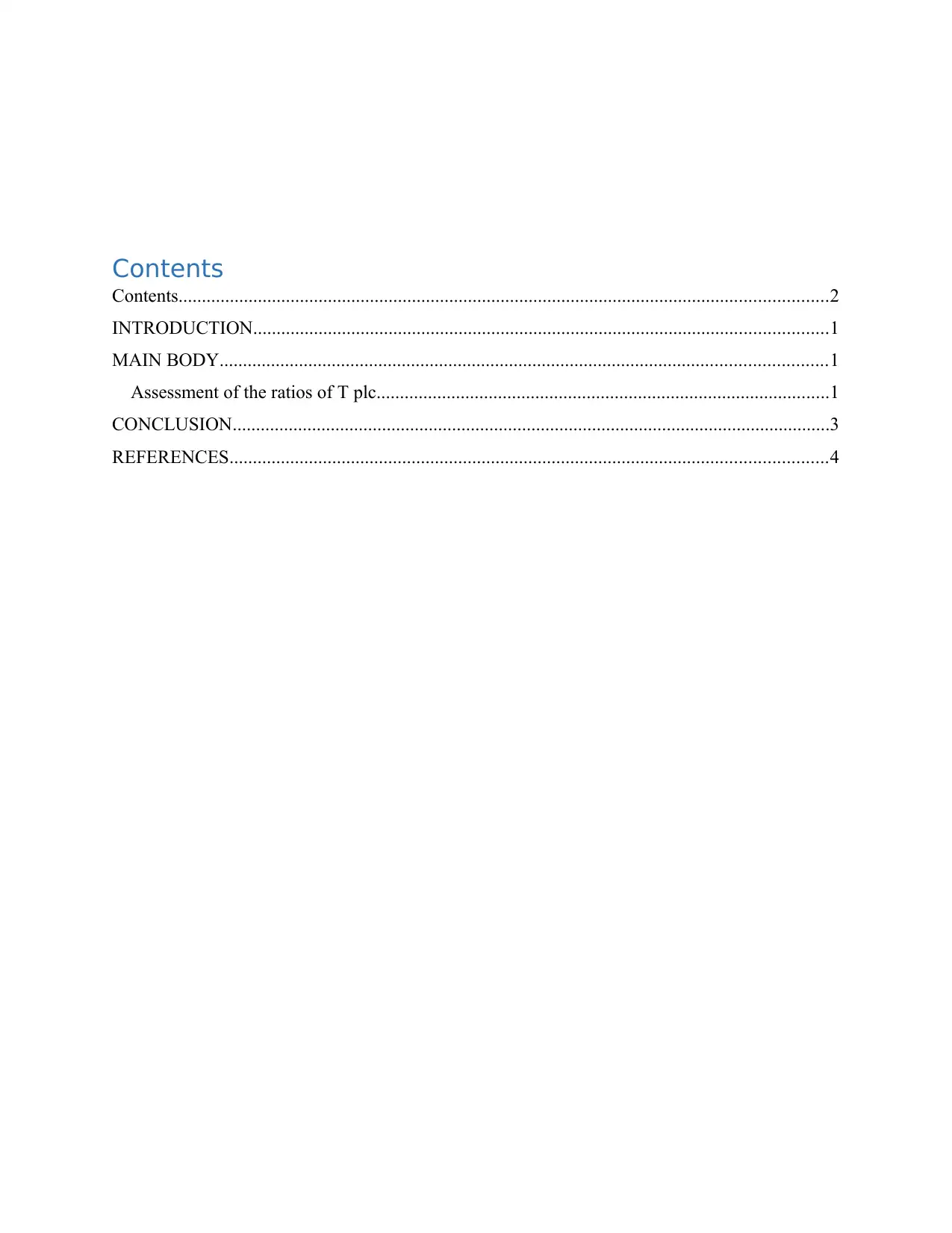
Contents
Contents...........................................................................................................................................2
INTRODUCTION...........................................................................................................................1
MAIN BODY..................................................................................................................................1
Assessment of the ratios of T plc.................................................................................................1
CONCLUSION................................................................................................................................3
REFERENCES................................................................................................................................4
Contents...........................................................................................................................................2
INTRODUCTION...........................................................................................................................1
MAIN BODY..................................................................................................................................1
Assessment of the ratios of T plc.................................................................................................1
CONCLUSION................................................................................................................................3
REFERENCES................................................................................................................................4
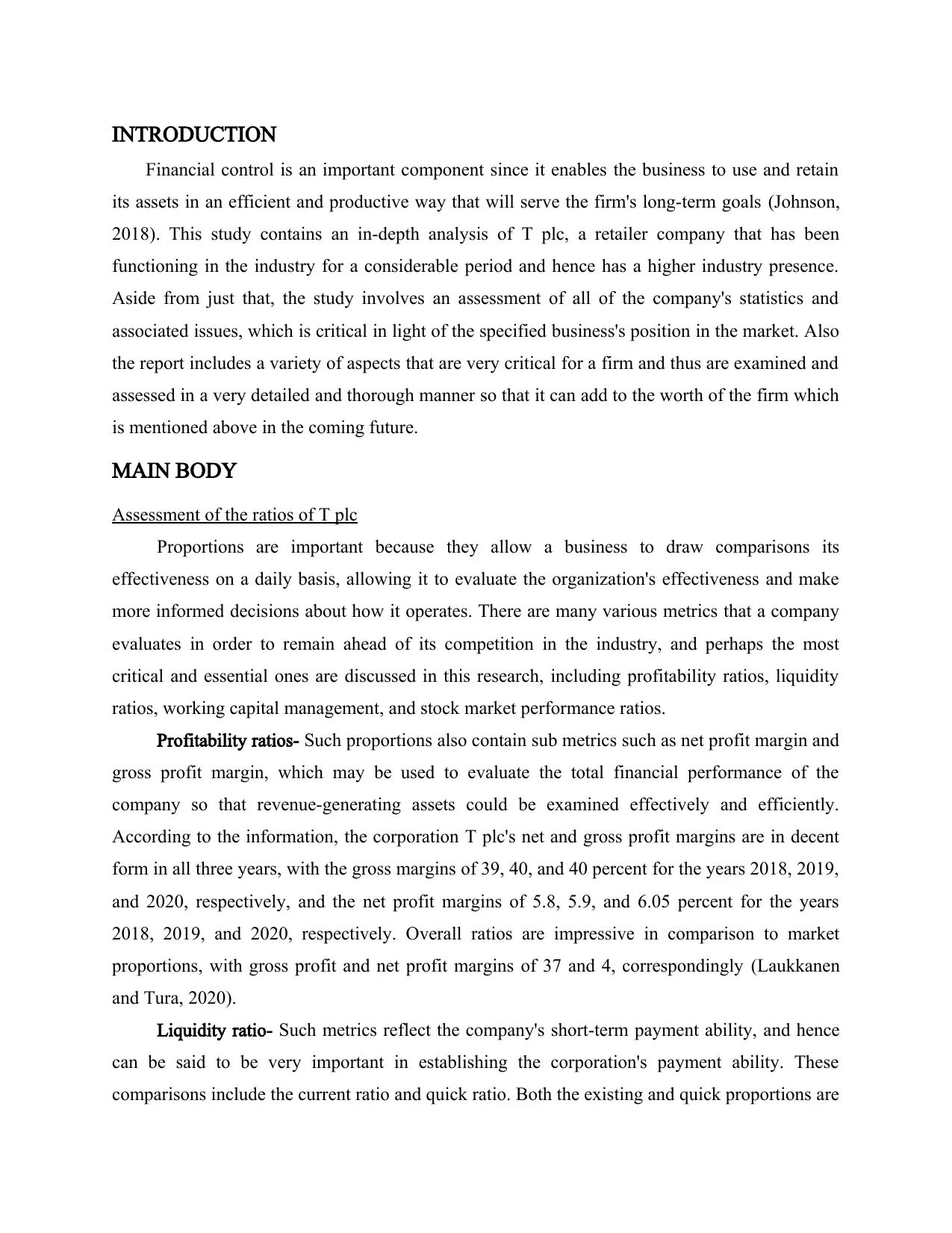
INTRODUCTION
Financial control is an important component since it enables the business to use and retain
its assets in an efficient and productive way that will serve the firm's long-term goals (Johnson,
2018). This study contains an in-depth analysis of T plc, a retailer company that has been
functioning in the industry for a considerable period and hence has a higher industry presence.
Aside from just that, the study involves an assessment of all of the company's statistics and
associated issues, which is critical in light of the specified business's position in the market. Also
the report includes a variety of aspects that are very critical for a firm and thus are examined and
assessed in a very detailed and thorough manner so that it can add to the worth of the firm which
is mentioned above in the coming future.
MAIN BODY
Assessment of the ratios of T plc
Proportions are important because they allow a business to draw comparisons its
effectiveness on a daily basis, allowing it to evaluate the organization's effectiveness and make
more informed decisions about how it operates. There are many various metrics that a company
evaluates in order to remain ahead of its competition in the industry, and perhaps the most
critical and essential ones are discussed in this research, including profitability ratios, liquidity
ratios, working capital management, and stock market performance ratios.
Profitability ratios- Such proportions also contain sub metrics such as net profit margin and
gross profit margin, which may be used to evaluate the total financial performance of the
company so that revenue-generating assets could be examined effectively and efficiently.
According to the information, the corporation T plc's net and gross profit margins are in decent
form in all three years, with the gross margins of 39, 40, and 40 percent for the years 2018, 2019,
and 2020, respectively, and the net profit margins of 5.8, 5.9, and 6.05 percent for the years
2018, 2019, and 2020, respectively. Overall ratios are impressive in comparison to market
proportions, with gross profit and net profit margins of 37 and 4, correspondingly (Laukkanen
and Tura, 2020).
Liquidity ratio- Such metrics reflect the company's short-term payment ability, and hence
can be said to be very important in establishing the corporation's payment ability. These
comparisons include the current ratio and quick ratio. Both the existing and quick proportions are
Financial control is an important component since it enables the business to use and retain
its assets in an efficient and productive way that will serve the firm's long-term goals (Johnson,
2018). This study contains an in-depth analysis of T plc, a retailer company that has been
functioning in the industry for a considerable period and hence has a higher industry presence.
Aside from just that, the study involves an assessment of all of the company's statistics and
associated issues, which is critical in light of the specified business's position in the market. Also
the report includes a variety of aspects that are very critical for a firm and thus are examined and
assessed in a very detailed and thorough manner so that it can add to the worth of the firm which
is mentioned above in the coming future.
MAIN BODY
Assessment of the ratios of T plc
Proportions are important because they allow a business to draw comparisons its
effectiveness on a daily basis, allowing it to evaluate the organization's effectiveness and make
more informed decisions about how it operates. There are many various metrics that a company
evaluates in order to remain ahead of its competition in the industry, and perhaps the most
critical and essential ones are discussed in this research, including profitability ratios, liquidity
ratios, working capital management, and stock market performance ratios.
Profitability ratios- Such proportions also contain sub metrics such as net profit margin and
gross profit margin, which may be used to evaluate the total financial performance of the
company so that revenue-generating assets could be examined effectively and efficiently.
According to the information, the corporation T plc's net and gross profit margins are in decent
form in all three years, with the gross margins of 39, 40, and 40 percent for the years 2018, 2019,
and 2020, respectively, and the net profit margins of 5.8, 5.9, and 6.05 percent for the years
2018, 2019, and 2020, respectively. Overall ratios are impressive in comparison to market
proportions, with gross profit and net profit margins of 37 and 4, correspondingly (Laukkanen
and Tura, 2020).
Liquidity ratio- Such metrics reflect the company's short-term payment ability, and hence
can be said to be very important in establishing the corporation's payment ability. These
comparisons include the current ratio and quick ratio. Both the existing and quick proportions are
⊘ This is a preview!⊘
Do you want full access?
Subscribe today to unlock all pages.

Trusted by 1+ million students worldwide
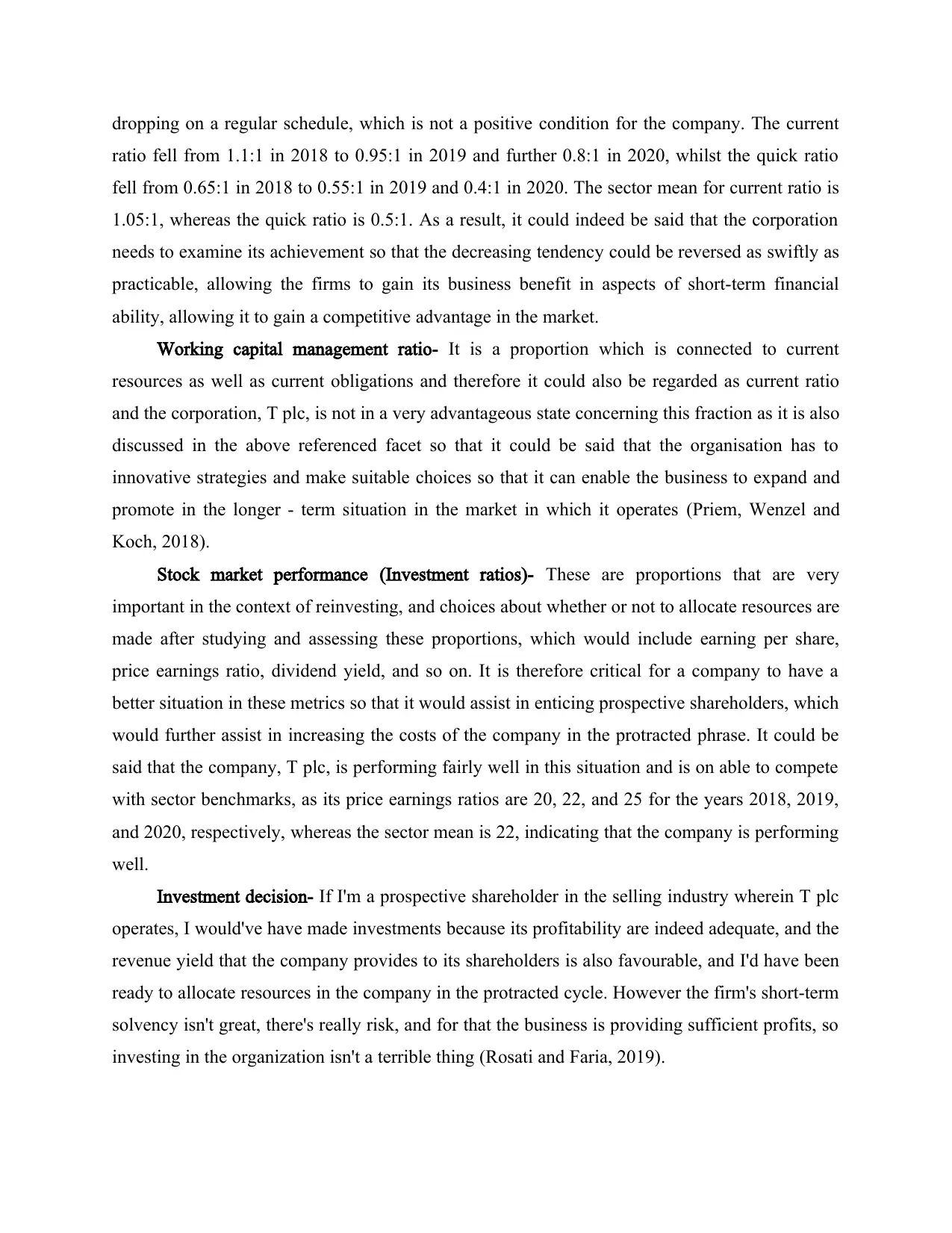
dropping on a regular schedule, which is not a positive condition for the company. The current
ratio fell from 1.1:1 in 2018 to 0.95:1 in 2019 and further 0.8:1 in 2020, whilst the quick ratio
fell from 0.65:1 in 2018 to 0.55:1 in 2019 and 0.4:1 in 2020. The sector mean for current ratio is
1.05:1, whereas the quick ratio is 0.5:1. As a result, it could indeed be said that the corporation
needs to examine its achievement so that the decreasing tendency could be reversed as swiftly as
practicable, allowing the firms to gain its business benefit in aspects of short-term financial
ability, allowing it to gain a competitive advantage in the market.
Working capital management ratio- It is a proportion which is connected to current
resources as well as current obligations and therefore it could also be regarded as current ratio
and the corporation, T plc, is not in a very advantageous state concerning this fraction as it is also
discussed in the above referenced facet so that it could be said that the organisation has to
innovative strategies and make suitable choices so that it can enable the business to expand and
promote in the longer - term situation in the market in which it operates (Priem, Wenzel and
Koch, 2018).
Stock market performance (Investment ratios)- These are proportions that are very
important in the context of reinvesting, and choices about whether or not to allocate resources are
made after studying and assessing these proportions, which would include earning per share,
price earnings ratio, dividend yield, and so on. It is therefore critical for a company to have a
better situation in these metrics so that it would assist in enticing prospective shareholders, which
would further assist in increasing the costs of the company in the protracted phrase. It could be
said that the company, T plc, is performing fairly well in this situation and is on able to compete
with sector benchmarks, as its price earnings ratios are 20, 22, and 25 for the years 2018, 2019,
and 2020, respectively, whereas the sector mean is 22, indicating that the company is performing
well.
Investment decision- If I'm a prospective shareholder in the selling industry wherein T plc
operates, I would've have made investments because its profitability are indeed adequate, and the
revenue yield that the company provides to its shareholders is also favourable, and I'd have been
ready to allocate resources in the company in the protracted cycle. However the firm's short-term
solvency isn't great, there's really risk, and for that the business is providing sufficient profits, so
investing in the organization isn't a terrible thing (Rosati and Faria, 2019).
ratio fell from 1.1:1 in 2018 to 0.95:1 in 2019 and further 0.8:1 in 2020, whilst the quick ratio
fell from 0.65:1 in 2018 to 0.55:1 in 2019 and 0.4:1 in 2020. The sector mean for current ratio is
1.05:1, whereas the quick ratio is 0.5:1. As a result, it could indeed be said that the corporation
needs to examine its achievement so that the decreasing tendency could be reversed as swiftly as
practicable, allowing the firms to gain its business benefit in aspects of short-term financial
ability, allowing it to gain a competitive advantage in the market.
Working capital management ratio- It is a proportion which is connected to current
resources as well as current obligations and therefore it could also be regarded as current ratio
and the corporation, T plc, is not in a very advantageous state concerning this fraction as it is also
discussed in the above referenced facet so that it could be said that the organisation has to
innovative strategies and make suitable choices so that it can enable the business to expand and
promote in the longer - term situation in the market in which it operates (Priem, Wenzel and
Koch, 2018).
Stock market performance (Investment ratios)- These are proportions that are very
important in the context of reinvesting, and choices about whether or not to allocate resources are
made after studying and assessing these proportions, which would include earning per share,
price earnings ratio, dividend yield, and so on. It is therefore critical for a company to have a
better situation in these metrics so that it would assist in enticing prospective shareholders, which
would further assist in increasing the costs of the company in the protracted phrase. It could be
said that the company, T plc, is performing fairly well in this situation and is on able to compete
with sector benchmarks, as its price earnings ratios are 20, 22, and 25 for the years 2018, 2019,
and 2020, respectively, whereas the sector mean is 22, indicating that the company is performing
well.
Investment decision- If I'm a prospective shareholder in the selling industry wherein T plc
operates, I would've have made investments because its profitability are indeed adequate, and the
revenue yield that the company provides to its shareholders is also favourable, and I'd have been
ready to allocate resources in the company in the protracted cycle. However the firm's short-term
solvency isn't great, there's really risk, and for that the business is providing sufficient profits, so
investing in the organization isn't a terrible thing (Rosati and Faria, 2019).
Paraphrase This Document
Need a fresh take? Get an instant paraphrase of this document with our AI Paraphraser
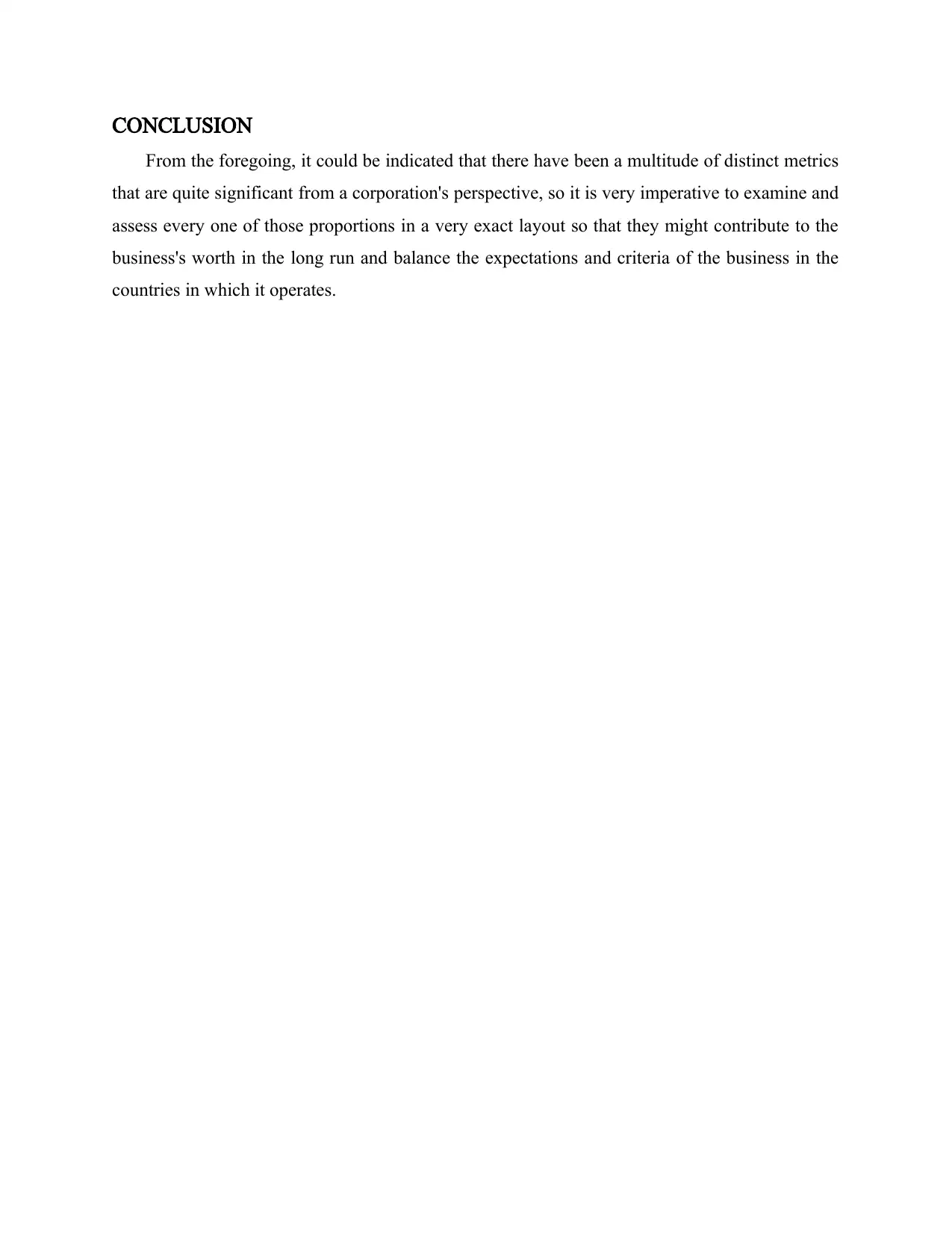
CONCLUSION
From the foregoing, it could be indicated that there have been a multitude of distinct metrics
that are quite significant from a corporation's perspective, so it is very imperative to examine and
assess every one of those proportions in a very exact layout so that they might contribute to the
business's worth in the long run and balance the expectations and criteria of the business in the
countries in which it operates.
From the foregoing, it could be indicated that there have been a multitude of distinct metrics
that are quite significant from a corporation's perspective, so it is very imperative to examine and
assess every one of those proportions in a very exact layout so that they might contribute to the
business's worth in the long run and balance the expectations and criteria of the business in the
countries in which it operates.
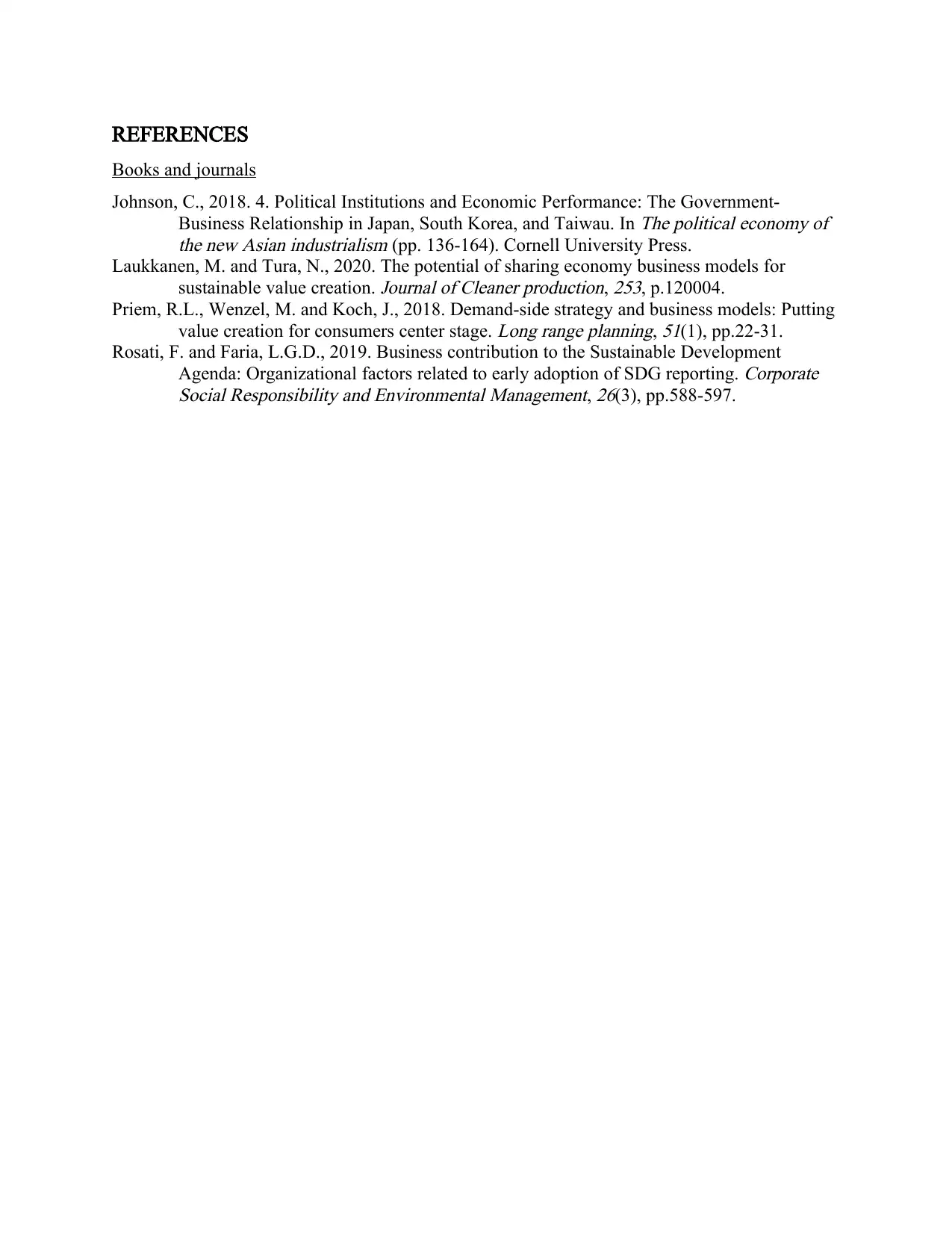
REFERENCES
Books and journals
Johnson, C., 2018. 4. Political Institutions and Economic Performance: The Government-
Business Relationship in Japan, South Korea, and Taiwau. In
The political economy of
the new Asian industrialism (pp. 136-164). Cornell University Press.
Laukkanen, M. and Tura, N., 2020. The potential of sharing economy business models for
sustainable value creation.
Journal of Cleaner production,
253, p.120004.
Priem, R.L., Wenzel, M. and Koch, J., 2018. Demand-side strategy and business models: Putting
value creation for consumers center stage.
Long range planning,
51(1), pp.22-31.
Rosati, F. and Faria, L.G.D., 2019. Business contribution to the Sustainable Development
Agenda: Organizational factors related to early adoption of SDG reporting.
Corporate
Social Responsibility and Environmental Management,
26(3), pp.588-597.
Books and journals
Johnson, C., 2018. 4. Political Institutions and Economic Performance: The Government-
Business Relationship in Japan, South Korea, and Taiwau. In
The political economy of
the new Asian industrialism (pp. 136-164). Cornell University Press.
Laukkanen, M. and Tura, N., 2020. The potential of sharing economy business models for
sustainable value creation.
Journal of Cleaner production,
253, p.120004.
Priem, R.L., Wenzel, M. and Koch, J., 2018. Demand-side strategy and business models: Putting
value creation for consumers center stage.
Long range planning,
51(1), pp.22-31.
Rosati, F. and Faria, L.G.D., 2019. Business contribution to the Sustainable Development
Agenda: Organizational factors related to early adoption of SDG reporting.
Corporate
Social Responsibility and Environmental Management,
26(3), pp.588-597.
⊘ This is a preview!⊘
Do you want full access?
Subscribe today to unlock all pages.

Trusted by 1+ million students worldwide
1 out of 6
Related Documents
Your All-in-One AI-Powered Toolkit for Academic Success.
+13062052269
info@desklib.com
Available 24*7 on WhatsApp / Email
![[object Object]](/_next/static/media/star-bottom.7253800d.svg)
Unlock your academic potential
Copyright © 2020–2025 A2Z Services. All Rights Reserved. Developed and managed by ZUCOL.




